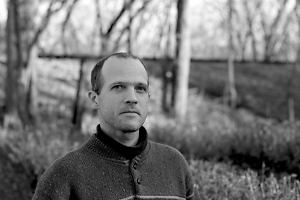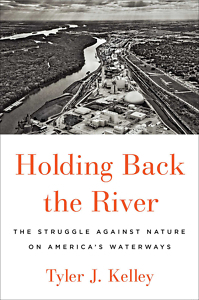Rivers Untamed
Tyler J. Kelley chronicles great American rivers and a century of effort to control them
The Mississippi, the Ohio, the Missouri, and the Arkansas rivers loom large in American history. Since colonial times, they have served as essential highways for the country’s crops and freight, which is why cities grew along their banks — despite the rivers’ propensity for mighty floods. In Holding Back the River: The Struggle Against Nature on America’s Waterways, Tyler J. Kelley uses the stories of several memorable characters to examine the history of efforts to tame the rivers. He also considers a daunting future of crumbling levees and rising waters.
 Kelley, a journalist who has written for The New York Times and The Wall Street Journal, writes his first book in a style reminiscent of John McPhee, explaining complex subjects by profiling interesting people attached to them, supplementing contemporary stories with historical anecdotes. The barge operators, farmers, and engineers Kelley meets explain the continued importance of America’s rivers and the challenges they face from aging infrastructure and the increased floods of climate change.
Kelley, a journalist who has written for The New York Times and The Wall Street Journal, writes his first book in a style reminiscent of John McPhee, explaining complex subjects by profiling interesting people attached to them, supplementing contemporary stories with historical anecdotes. The barge operators, farmers, and engineers Kelley meets explain the continued importance of America’s rivers and the challenges they face from aging infrastructure and the increased floods of climate change.
He shared some thoughts about recent river events and answered questions about the book via email:
Chapter 16: What first drew you to the great rivers and the people who live along them?
Tyler J. Kelley: A friend and I were putt-putting down the Ohio River in a 16-foot aluminum boat, camping on the bank at night. On the afternoon of what we thought was our last day, our outboard motor broke down just past Lock and Dam No. 53, in far southern Illinois. A worker there didn’t like the look of us rowing clumsily toward the Olmsted construction site, so he hopped in a skiff and towed us back to the lock. I ended up sleeping on the bench seat of the lock’s little towboat, cooking dinner in the pump house with a lockman named Mike Burton, and watching him fire up the massive steam boiler on their maneuver boat, which they used to operate the dam. The next morning, I met Randy Robertson, No. 53’s lockmaster. He asked two of his mechanics to look at our outboard and, after scrubbing the sparkplugs and adding something to our fuel to counteract the watery Kentucky gas, we were on our way. We passed the awesome spectacle of Olmsted Locks and Dam, then about two-thirds complete, and proceeded to Cairo, the last stop on our journey.
I had glimpsed a world, and I couldn’t stop thinking about it.
Chapter 16: You delve deeply into the history of rivers, dams, levees, and canals. What was the most surprising historical tidbit you uncovered while researching the book?
Kelley: The Mississippi River’s way of reacting to manmade interventions, to our attempts to control it. A phrase you hear when military or political leaders are discussing a terrorist attack or something, they say “we will respond at a time and place of our choosing.” That’s how the Mississippi works, too, but we forget that the river deals in centuries, while we tend to think in four-year increments.
In the 1930s and 40s, engineers cut through 16 bends on the Mississippi between Memphis and Natchez, straightening and shortening the river and lowering flood crests dramatically — sounds good right? Well, for the last 90 years the river has been responding to these cutoffs. Now we have a sediment buildup — the bed of the river is actually rising — near Old River Control and Bonnet Carré in Louisiana, a stretch of river where we really can’t afford to increase flood risk. Meanwhile, north of Memphis, we have a lowering of the river’s bed; the Mississippi is eating downward, and if this erosion makes it past a mysterious clay ridge on the river bottom near Hickman, Kentucky, it could lead to bluff sliding and levees eroding and barges running aground all around the Ohio-Mississippi confluence.
The U.S. Army Corps of Engineers don’t know how to stop these two parallel phenomena, which are the river’s reactions to something a haughty general decided to do almost 100 years ago.
 Chapter 16: As a journalist, what was it like to spend days at a stretch alongside rough-talking, tobacco-spitting boatmen and dam operators, often as they performed dangerous duties?
Chapter 16: As a journalist, what was it like to spend days at a stretch alongside rough-talking, tobacco-spitting boatmen and dam operators, often as they performed dangerous duties?
Kelley: As a journalist, it was wonderful. Every journalist wants to meet interesting people and see interesting things happen in real time. I was fortunate enough to be allowed — by some very generous and candid individuals like Luther Helland, who was master of Lock and Dam No. 52, and Shane Byassee, who is master of Olmsted — to get up close while these dams were being raised, or the raisings were being attempted. People were willing to let me see them being imperfect, being upset, frustrated, dealing with problems they hadn’t created and yet had to solve. Especially those who were tasked with operating these falling-apart locks and dams.
It’s like the federal government promised big ag and millions of farmers that this river shipping system works and will work for them and their customers every day, and it has been the unenviable job of people like Luther Helland to say, “We can’t do this; the promises that our bosses back in Washington D.C. made to you, they’re false. This doesn’t actually work.” A handful of people out on a big dangerous river in a lonesome corner of Illinois are stuck between these two huge corporate bureaucracies. It’s extremely stressful, and I saw that firsthand.
Chapter 16: My mother’s family grew up on a farm near Olmsted, Illinois, and in recent decades my uncle would take visitors to observe the rising spectacle of the expensive Olmsted Dam on the Ohio. You describe the so-called “opening” of this dam in 2018, when it was not yet fully operable, followed by an incredibly difficult process to reach barest functionality a few days later. How has the multi-billion-dollar structure fared since then?
Kelley: It’s working. The story of Olmsted, as I see it, is not that it’s a terribly flawed structure — it will do what it’s supposed to do — but that the process of getting it built was terribly flawed. Twenty years behind schedule and $2 billion over budget because the Corps wanted to “innovate,” or it was pushed to “innovate,” and because Congress funded (and continues to fund) these projects in a piecemeal way, giving them a bunch of money one year and nothing the next.
At the Olmsted ribbon cutting, I asked the chief of the Corps and the secretary of the Army for Civil Works, who oversees the Corps, what had changed — what new protocols were in place to prevent such a wasteful and time-consuming process from repeating itself the next time the Corps wanted to build something? Didn’t this set a really bad precedent?
They didn’t have an answer.
A Corps official from St. Louis whom I spoke with, Andy Schimpf, made an excellent point: When Olmsted took longer and cost more, who suffered? Not the Corps’ project managers. Not the contractors. The politicians didn’t mind as long as they had jobs and dollars to dole out. The towing industry and the big agriculture conglomerates got their spiffy new locks in the end. Everybody won except for the taxpayer.
There’s been reporting recently on how much fraud and waste there was in the COVID relief bills. Now, I’m not a small government person who says the feds should walk away and leave it all up to the private sector. That would be a disaster. But I don’t see a taxpayer advocate sitting at the table, not then, and not now.
Chapter 16: One boat captain in the book, in trying to find an analogy for the economic cost of a closed lock, asked, “What would happen if both lanes of I-95 were completely shut down for three of four days?” Eerily, that’s almost exactly what happened when a crack on the I-40 bridge in Memphis recently led to a one-day closure to river traffic, creating a backlog of 1,000 barges. What would be the impact of a longer closure, and how prepared are we to deal with it?
Kelley: We’re not prepared to deal with it. The I-40 bridge closure is exactly what happened over and over again with the failing locks and dams that Olmsted replaced, and there are still many almost-as-old structures on the Illinois and upper Mississippi rivers. A lot of the basic building blocks of the economy move by water because it’s the cheapest way to move a lot of anything: oil, coal, chemicals, grain, fertilizer, steel. Almost all of the grain exported from the U.S. ends up on the Mississippi. There isn’t enough space on the roads or railways for the goods that are currently moved by water, since one 15-barge tow carries 216 train cars or over 1,000 trucks worth of goods. The multi-modal interconnected economy we’ve built could not exist without the waterways, and arguably it could be improved by improving the waterways.
Not talking about a total shutdown, but just looking at declining investment, a USDA study found that, while U.S. waterborne transportation is getting slower and more expensive, Brazil — with China’s help — is busy expanding its railroads, grain elevators, and export terminals. Brazil is the world’s other big grain exporter and China is the world’s biggest grain buyer. Unless we spend more to upgrade our system, U.S. agriculture will lose its competitive edge. By 2045, if American lock chambers haven’t been built bigger and made more reliable, Brazilian grain will dominate the world market. Farm ground in the American heartland will go out of production; farmers will make less money; small-town economies will suffer; and, as freight moves off the river and onto roads and rails, congestion, fatalities, and carbon emissions will all increase.
Chapter 16: If Congress and the president can agree on major infrastructure funding, what do you think it will take to safeguard the river economy, as well as the cities and towns endangered by ever-greater floods?
Kelley: I fear that all the talk of “crumbling” infrastructure implies that everything should be rebuilt just as it was, if not bigger. That would be a mistake. That would be returning to the values of 1950 and an equally dated set of assumptions about the economy and the climate. As I think the Biden administration knows, the aging infrastructure and climate change questions actually have the same answer: Rebuild smarter, not bigger. We need to prepare for the extreme weather that is coming and is already here, and part of that preparation — as the Dutch can tell us — actually involves un-building, taking structures down, as well as building things up. As we protect the places we deem vital and allow lower value areas to flood once in a while, we need to relocate and compensate people — because there will be losers — with a sense of justice and just compensation in mind because, historically, the losers when a highway or a dam went in were often indigenous people, poor people, and people of color.
We must also remember that infrastructure shapes the economy, as well as the other way around. For instance: We have all this infrastructure dedicated to mining, loading, and moving coal; meanwhile, cheap natural gas and environmental regulations are killing the coal industry. Global commerce moves via shipping containers — those colorful metal boxes you see on trains and ships and trucks and warehouse loading docks all over the world — yet the container-on-barge business is still in its infancy. Imagine taking all that money spent on coal infrastructure and moving it over to fund and incentivize container-on-barge. All of a sudden river commerce is booming, there’s new investment, new jobs. New ports are built and river towns begin to grow, and the whole sector is greener and more efficient than ever before.

Michael Ray Taylor is the author of Hidden Nature: Wild Southern Caves. He chairs the communication and theatre arts department at Henderson State University in Arkadelphia, Arkansas.





